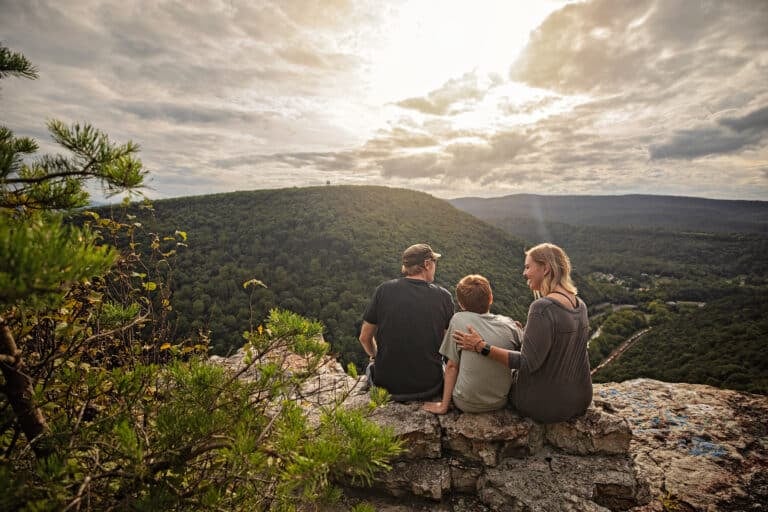by Jedd Ferris
Environmental Issues In our Blue Ridge Backyard
Environmental issues affect our everyday lives, but they seem so over-arching and global that it's hard to know what to do about them. Here are five of the most important issues facing the Southeast-and five easy ways you can help
1. Air Pollution
The most immediate threat to health and the environment in the Southern Appalachians is poor air quality. Old and dirty coal-burning power plants in the Southeast are saturating the mountains with sulfur dioxide, nitrogen oxide, and mercury. This causes acid rain, lung-burning ozone, contamination of fish, and skyrocketing asthma rates-asthma attacks are the most common cause of school absenteeism in this region. Many tree and rare plant species are disappearing because air pollution has weakened their immune defenses making them more susceptible to attack by insects and diseases. And the region's scenic vistas-a key compnoent of tourism-are smothered by blankets of smog.
The Canary Coalition-a grassroots group in the Southeast focused exclusively on air pollution- fights for strong laws and enforcement of existing regulations to reverse this damage and improve air quality: visit www.canarycoalition.org.
2. Sprawl-Southern Style
The South is the fastest growing region in the country. Between 1990 and 2000, the region’s population increased 20% (compared to a national increase of 13%). More disturbing, though, is the amount of land being plowed under and paved to provide houses, stores, restaurants, roads, schools and other services for all these people. Every day, 2,000 acres of lush Appaachian forest, rolling Piedmont, and pristine coastline are lost to sprawl in the Southeast. Even worse, the density of that development is decreasing-meaning we’re sprawling ever further out from urban centers as we gobble up farms, fields, and forests.
All this sprawling development means more driving. The South has the highest driving rates in the country; in 2000, we drove a total of 1.6 billion miles every day. Not only does this deplete our time for work, play, and family, it’s destroying the very landscapes and environment that drew us here in the first place.
Over 20 million Southerners live in areas that fail to meet federal health standards for air quality. In our car-dependent society, too many of our children are growing obese. Muddy runoff from construction and pavement-another effect of sprawl-is one of the region’s most prevalent water quality problems. A one-acre parking lot creates 16 times more runoff than a one-acre meadow.
But don’t despair. As these sprawl-related problems grow, so too do the efforts of local organizations and citizens to find solutions. There are now some 120 land trusts in the Southeast permanently protecting about 625,000 acres. And a number of states-including North Carolina and Georgia-have instituted land acquisition programs. Funding for transit and other transportation alternatives is rising (although it's still a drop in the bucket from what is needed). And increasingly, communities are taking steps to encourage more compact, mixed-use development. The Southern Environmental Law Center has helped coordinate many of these efforts; find out more about its Land & Community Project at www.SouthernEnvironment.org.
3. Mountaintop Removal
Not far from some of Appalachia’s most famous whitewater, mountain biking, and hiking destinations, a great tragedy is taking place. In the coalfields of Appalachia, entire communities are being driven off their land by flooding, landslides, pollution, and blasting resulting from mountaintop removal coal mining. Mountaintop removal has already ravaged large areas of southern West Virginia and eastern Kentucky, and it is quickly spreading into southwest Virginia and east Tennessee.
Mountaintop removal involves blasting off the tops of mountains and dumping the rubble into valleys below. Since the 1980s, mountaintop removal has obliterated well over 400,000 acres of mountains and buried over 1,000 miles of streams. Coal companies are increasingly using this method because it allows for almost complete removal of coal seams while reducing the number of coal miners employed.
This is happening in a region famous for fantastic outdoor recreation opportunities, a rich cultural heritage, and some of the most diverse forests and streams in the world. Tourism, not coal mining, is the fastest growing industry in the region, and many coalfield residents fear that the devastation left behind by mountaintop removal will ruin all future possibilities for sustainable economic development.
Appalachian Voices is one of the groups working with coalfield residents to end mountaintop removal. Take a virtual tour of a mountaintop removal site at www.appalachianvoices.org.
4. ABUSES TO OUR NATIONAL FORESTS
National Forests provide a complex set of ecological benefits such as clean air and temperature regulation; clean drinking water for 2,200 communities and over 10 million people in the region; space to hike, run, climb, paddle, and indulge in countless other outdoor recreation activities; and a place to find peace of mind and spiritual renewal in our hectic world. Here are the top five threats to Southern Appalachian National Forests:
Logging-It’s not radical to want to keep logging out of certain areas in our national forests. Logging in old growth forests and roadless areas just doesn’t make sense – these small pieces of our national forests have far more value to us than the timber, and they are critical components of overall forest structure and health.
Roads-Road building is highly destructive to forests. Logging roads fragment natural areas, creating routes that permit additional logging, off-road vehicle use, and penetration by exotic species.
Invasive/exotic species-Introduced species without natural predators or other controls frequently out-compete and displace native species. Non-native pests attack the foundations of our ecosystem and threaten to remove them and the species that rely on them.
Emerging policies–Most of the new national forest policies go against science and public input, while legislation that is already in place to protect our national forests is being dismantled. Not nearly enough sound forest restoration is happening in our region and critical areas such as roadless and old growth forests are more at risk than ever.
Lack of public input/awareness-C’mon, let’s sing: “This land is your land, this land is my land…this land was made for you and me.” It’s true, you own these forests. Unfortunately, we are busy people and we don’t realize how easy and important it is to stay in touch with how your favorite national forest is being managed. Sometimes a two-minute phone call or emailing one sentence can make all the difference in the world.
Southern Appalachian Forest Coalition works with a broad range of environmental groups, the Forest Service, and individuals in the region to protect and restore our Southern Appalachian national forests. Get on the Friends of the Forest email list at www.SAFC.org.
5. Global Warming in the Sultry South
The verdict is in – global warming is happening . What does that mean for us in the mountains? The overall warming of our earth’s temperature, will have substantial impacts to our mountain ecosystems. A University of Washington study found that increases in average temperatures by 1.8 degrees could push snow lines up by 500 feet or higher, greatly limiting ski areas in the Southeast. Changes in temperature and precipitation will stress our natural environment, leaving plants and trees more susceptible to disease and invasive pests. Projections show that global warming could destroy the spruce pine ecosystems, which thrive in colder mountain temperatures. Warmer temperatures will also lead to more urban smog days in the summer and encourage the migration of pests carrying tropical diseases northward, some of which have already been found in our region. Stronger hurricanes could reach farther inland and cause excessive flooding in our urban communities, like tropical storm Frances did in Western North Carolina in 2004.
More than 61 percent of our electricity in the Southeast comes from decades-old, coal-burning power plants, which annually pump hundreds of millions of tons of global warming pollution into the atmosphere. These dinosaurs can be phased out, cleaned up or replaced with cleaner sources, such as renewable energy and advanced technologies. While legislation in Washington, D.C. stagnates, cities, states, and businesses are taking matters into their own hands. Last year North Carolina’s legislature passed the Global Warming Act, creating a Commission to look at the state’s contribution to global warming pollution and provide policy recommendations in November of 2007. Ski areas like Cataloochee in North Carolina, Wintergreen and Massanutten in Virginia, and Snowshoe in West Virginia, have endorsed “Sustainable Slopes,” a program that emphasizes pollution reduction through reducing energy consumption and using clean fuels.
For more info visit Southern Alliance for Clean Energy’s website, www.cleanenergy.org.
5 EASY WAYS TO MAKE A DIFFERENCE
1. Stay informed: Bookmark a few key web sites and tune in to environmental news. It can seem very doom-and-gloom sometimes, but focus on finding solutions, big and small.
2. Talk to people about these issues and how you feel about them. Having conversations with friends and family will help raise the issues to others. Let them know that it’s not just tree-hugging hippies that care about our environment – these issues affect everyone’s health and security.
3. Realize that our democracy is tangible and accessible to you – all you have to do is jump in and make your voice heard. Your taxes pay the salaries of your Congressional representatives – let them know what’s on your mind. And keep letting them know.
4. Use the media. The media plays a major role in setting agendas and framing issues. The most read portion of any newspaper is the opinion section – so send in those letters-to-the-editors to call out biased reporting or help tell the whole story.
5. Look into the organizations that are working on the issues that you care about and join one. People who have contributed money to a non-profit organization report that they get back more satisfaction and joy than they expend. Every dollar means something and makes a difference. Alternatively, joining an email list, volunteering an hour a week, or attending a local event can provide a sense of community and empowerment.







